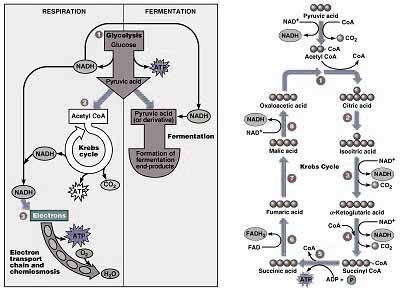Krebs Citric Acid Cycle
Krebs Citric Acid Cycle Assignment Help | Krebs Citric Acid Cycle Homework Help
Krebs Citric Acid Cycle
It has been seen that pyruvic acid is converted either into ethyl alcohol or lactic acid fermentation or lactic acid (lactic acid fermentation or muscle glycolysis) in the absence of oxygen (anaerobic condition). In the presence of oxygen (aerobic condition), however, its metabolism is different. Pyruvic acid is oxidized to acetyl-CoA, which then undergoes a series of changes referred to as Krebs citric acid cycle.(1) Formation of citric acid. The first step in the citric acid cycle is the condensation of the 2-carbon-atom acetyl-CoA with a 4-carbon atom oxaloacetic acid molecule to form a 6-carbon-atom molecule of citric acid. This reaction is irreversible. Acetyl-CoA gives its acetyl group to oxaloacetic acid to form the citric acid molecule. CoA is released and reacts with more pyruvic acid.
(2) Dehydration. Citric acid is undergoes dehydration under the catalytic action of the enzyme aconitase to form cis-aconitic acid (6 carbon atoms).
(3) Hydration. Cis-aconitic acid is rehydrated to isocitric acid, again under the influence of aconitase. The transformation of citric acid to isocitric acid is one of isomerization. Citric acid can also yield isocitric acid is one of isommerization. Citric acid can also yield isocitric acid without cis-aconitic acid occurring as a free intermediate.
(4) Dehydrogenation I. Isocitric acid undergoes dehydrogenation in the presence of the enzyme isocitrate dehydrogenase to form oxalosuccinic acid. The pair of hydrogen atoms removed is accepted by NAD+ to form NADH + H+.

(5) Decarboxylation I. Oxalosuccine acid undergoes decarbxylation to form a-ketoglutaric acid. One CO2 is removed. Because of loss of one carbon atom during decarboxylation the α-ketoglutaric molecule has five carbon atoms. The reaction is catalyzed by carboxylase.
(6) Dehydrogenation II and Carboxylatoin II. α-ketoglutaric acid undergoes simultaneous decarboxylation and dehydrogenation and joins with coenzyme A to form succinyl-CoA, a 4-carbon atom derivative of coenzyme A.
(7) Phosphoryltion of ADP. Succinic acid is released from succinyl CoA under the catalytic action of succinic thiokinase. CoA is released in the reaction. The reaction requires GDP (guanosine diphosphate) or IDP (inosine diphosphate).
(8) Dehydrogenation III. Succinic acid undergoes dehydrogenation under the catalytic action of succiante dehydrogenase to form fumaric acid. The pair of hydrogen atoms formed is transferred directly to flavoproteins without the participation of NAD+.
(9) Hydration II. Fumaric acid is hydrated to form malic acid. The reaction is catalyzed by the enzyme fumarase.
(10) Dehydrogenation IV. In the final reaction malic acid is transformed into oxalocetic acid, which is thus regenerated. The catalytic enzyme is malate dehydrogenase. Dehydrogenation takes place during the process.
For more help in Krebs Citric Acid Cycle please click the button below to submit your homework assignment.